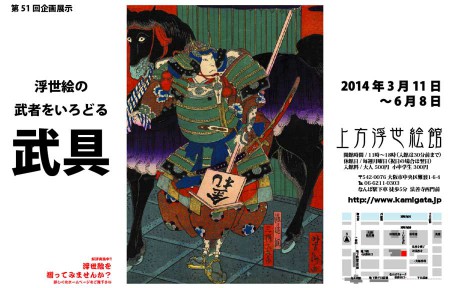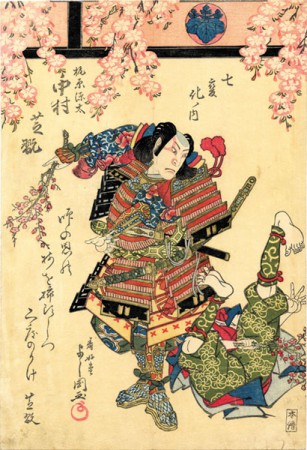Armor that embellish Samurai in Ukiyo-e
March 11 – June 8, 2014

This museum exhibits Ukiyo-e prints and paintings produced in Osaka in the Edo period. Most of them are of the actors playing Kabuki in theatres mainly in Dotombori area. Many of them are actors’ portraits in theatrical costumes of the roles they are playing, make us imagine the stages at the time.
Many of the Kabuki plays are either about historical events (jidai mono) or about ordinary lives of townsmen (sewa mono). In jidai mono, samurai world from as ancient as Nara period are often shown, with still-famous samurais in them.
In this feature exhibition, we focus on the Kabuki actors portraits in their samurai costumes. Armor, as well as swords and bows and arrows show the grief of samurai warriors who had to fight in a number of battles. Enjoy the armor depicted in Ukiyo-e, also enjoy their beautiful colors. Enjoy the picture of famous swords, too.

Kojitsuke nagara mane shichi henge Painted by Jukodo Yoshikuni
Armor that embellishes actors
Cuirasses and helmets were first manufactured in Japan in Yayoi period and evolved to protect bodies in battles as the way of fighting changed. In late Heian period ‘oyoroi style’, a set of armor with a helmet, cuirass, and osode (broad sleeve) emerged.
Sendan-no-ita (bead wood plate) and kyubi-no-ita (solid iron plate) were hung from the shoulders to protect the right side and left side of the chest respectively, but later became nominal and smaller in size. Kusazuri (protective skirt suspended from the cuirass) was later divided into 8 pieces as oyoroi style changed to domaru (a type of chest armor), haramaki (also a type of chest armor), and then to tosei-gusoku (more modern suit).
But after long period of peaceful times, it became difficult even for samurai warriors to wear it and armor got more decorative rather than practically useful.
Armor depicted in Ukiyo-e contributs to embellish Kabuki actors playing a samurai role rather than to express the atmosphere of the time in the play. Designs of odoshi (the braided cords that connect individual scales) which are seen on sendan-no-ita and osode gorgeously decorate the samurai costume in Kabuki plays.
Armor that makes plays gorgeous
Armor is not only stage properties, but also can be the pivot of the play. Some are essential for the play in which a master perfectly handles famous sword or the armor. Among the Japanese swords that symbolize samurai warriors, the well-known excellent sword including “Masamune” and “Muramasa” have a number of legends and historical episodes from which the plays were written.
Among the Ukiyo-e prints in this feature exhibition, there are three prints that have excellent episodes. The first one is “Sukeroku yukari no Edozakura”. The main character Sukeroku goes in and out of the Yoshiwara (licensed prostitution quarters in Edo town) picking a fight in order to find the sword “Tomokirimaru”, a Genji (Minamoto family) treasure. Finally he finds out that Ikyu has the sword he’s looking for and kills Ikyu. The second one is “Satomi Hakkenden”. “Murasamemaru” is said to make the miracle water come out from inside the sword everytime it cuts a person and never keep the blood remaining on it. The third one is “Ise ondo koi no netaba”. The main character Fukuoka Mitsugi tries to take back the famous sword called “Aoi shimosaka” for his master, but as his intimate prostitute dumped him, he got angry and killed ten people in a row with the sword. Thus, the plays concerning swords, as well as the swords’ sharpness, make us feel chilly.
There are various kinds of weapons appear in the Kabuki plays other than swords; spears and guns for example. Sword masters and bow and arrow experts are also appear in the plays. Take a look at these armors and weapons that dramatize actors poses and battle fight scenes.